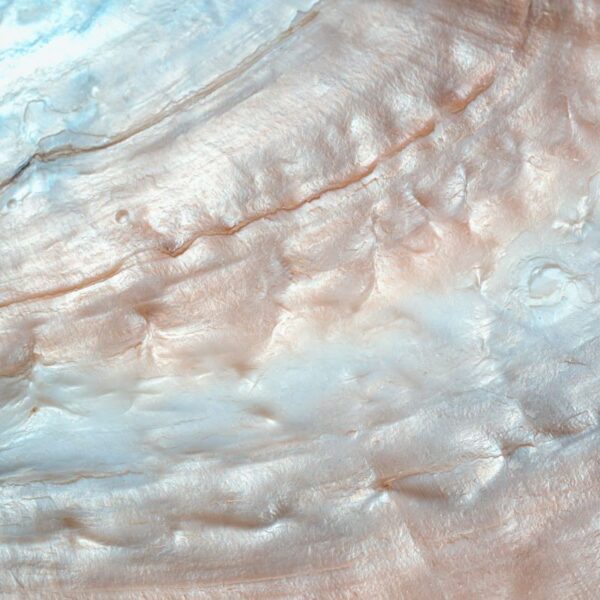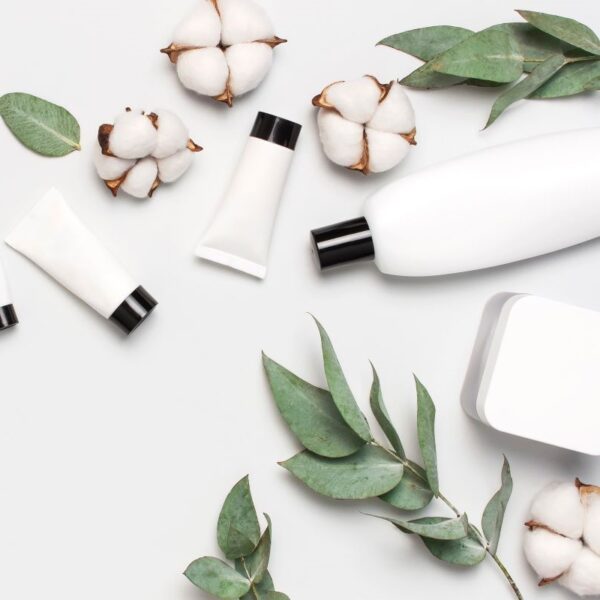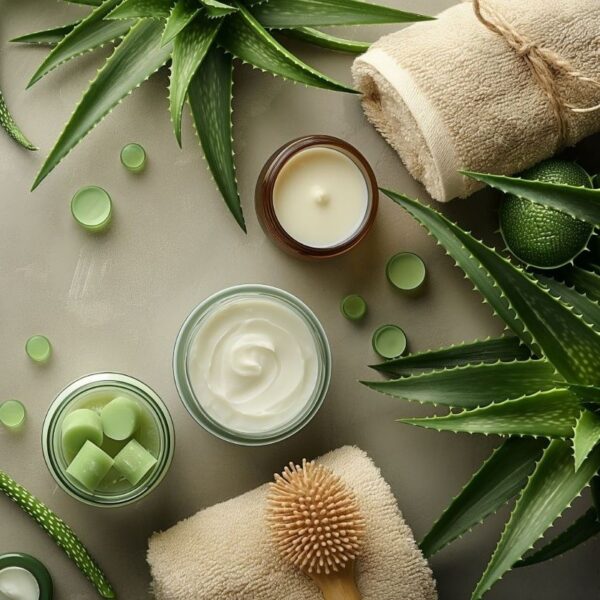Gelatin is a versatile biopolymer derived from collagen. It’s used in personal care products and cosmetics to enhance texture, elasticity, and stability. Gelatin plays a crucial role in these products and contributes to their effectiveness and sensory appeal.
What is Gelatin?
Gelatin is a protein found in collagen in the skin, bones, and connective tissue of animals. It primarily consists of a mixture of peptides and proteins produced by the partial hydrolysis of collagen. Gelatin also contains small amounts of other components such as water, minerals, and carbohydrates.
How is Gelatin Produced?
Gelatin is prepared by boiling animals’ skin, bones, and connective tissue. The process extracts collagen, a fibrous protein, into gelatin, a flavorless and colorless substance. Gelatin derived from pig skin is typically called type A gelatin, whereas beef skin is called type B gelatin.
Enzymatic methods to produce gelatin continue to evolve and have succeeded in demineralizing collagen from ossein, which has improved the predictability of quality and yield. Genetically engineered sources of collagen and gelatin are also being researched.
Use of Gelatin in Personal Care
Gelatin serves a variety of purposes in personal care products and cosmetics. It acts as a binder, helping ingredients adhere together to form a cohesive product. It is also a thickener, providing a smooth and luxurious consistency to creams and lotions. Gelatin is also recognized for its moisturizing properties, making it useful in moisturizers and serums.
Applications in Personal Care
| Function | Applications |
| Thickener | Gelatin can form a gel-like consistency when dissolved in water. This property helps to give the product a desirable texture and consistency. |
| Film-Forming Agent | When applied topically, gelatin can form a thin film on the skin or hair. This film helps to retain moisture, providing a hydrating effect and improving the overall appearance and feel of the skin or hair. |
| Binding Agent | Gelatin can act as a binding agent, helping to hold the ingredients of a cosmetic product together. This is particularly useful in products such as creams, lotions, and masks, with a desired cohesive texture. |
| Emulsifier | Gelatin can act as an emulsifier, helping to stabilize oil-in-water emulsions. It helps to prevent the separation of oil and water phases in cosmetic products, ensuring a consistent and uniform product. |
Product Examples
| Type | Examples |
| Skincare | Cream, lotions, moisturizers, masks |
| Hair Care | Hair conditioners, styling gels, hair masks |
| Nail Care | Nail strengtheners |
| Makeup | Foundation, concealers, mascara |
Properties of Gelatin
| Physical Form | Solid, powder |
| Color | Colorless, turbid, sometimes |
| Odor | Odorless, can carry bouillon-like odor |
| Storage Temperature & Conditions | Stored between 35-65%RH and 15-25°C |
| Molecular Weight | 15 to 400 kDa |
| Gelling Temperature | 22.5°C |
| Melting Point | 25°C-40°C |
| Specific Gravity | 1.3-1.4 |
| Solubility | Water, polycyclic alcohols, ether, benzene, acetic acid |
Typical Formulations
Hair Thickening Composition
| Component | Composition (%) |
| Polyvinyl pyrrolidine | 5.6 |
| Gelatin | 1.3 |
| Cross-linked polyacrylic acid thickener | 0.3 |
| Triethanol amine | 0.5 |
| Methylparaben preservative | 0.25 |
| Perfume | 0.28 |
| Deionized treatment | 92.3 |
Source: Google Patents
Toothpaste
| Component | Composition (%) |
| Carboxymethylcellulose | 0.8 |
| Calcium carbonate | 25.0 |
| Sodium lauryl sulphate | 2.0 |
| Sodium myristoyl taurate | 0.5 |
| Gelatin | 3.0 |
| Glycerin | 12.0 |
| Sodium salt of p-hydroxybenzoic acid methyl ester | 0.2 |
| Fumed silica | 2.0 |
| Flavoring agent | 2.0 |
| L-Blue No. 3 | 0.006 |
| Water, Demineralized | qs 100 % |
Source: Google Patents
Gelatin Formulation Considerations
| Physical Forms | Powder |
| Stability | – pH: Can undergo hydrolysis at higher alkaline pH – Temperature: Strength rapidly declines over 100°C. Degrades by 340°.C |
| Sensory Attributes | Odorless, colorless, no significant flavor (Variants can have color, taste, and odor depending on the processing conditions) |
| Dosage | 0.5-5%, depending on the application |
Properties Affecting the Functionality of Gelatin
| Property | Principle | Effect |
| Viscosity | Viscosity is partially controlled by molecular weight and molecular size distribution. [1] | It affects the thickening properties of gelatin and, thus, the final product’s texture. |
| Bloom Value | It reflects the average molecular weight of gelatin. | It is a measure of the strength and stiffness of gelatin. The higher the bloom value, the higher the melting and gelling points of a gel, and the shorter its gelling times. |
| Setting Point | The setting temperature of gelatin has been found to correlate with the imino acid content [2]. | The high gelling and melting points expand the range of gelatin application. |
| Foaming ability | The hydrophobic areas on the peptide chain are responsible for giving gelatin its emulsifying and foaming properties [3]. | It affects the foaming and stabilization properties of gelatin. Also, the fat binding properties. |
| Water Binding Capacity | Water binding capacity depends on the degree of exposure of the hydrophilic residues inside gelatin. | It affects the gelling properties and texturizing properties of gelatin. |
| Sensory properties | The sensory properties depend on the methods used for extraction. Deodorization is achievable in gelatin. | Sensory properties affect the consumer experience. Gelatin may create a foul odor, which can be unacceptable in certain applications. |
Safety and Regulatory Considerations
| FDA Information | In the United States, the Food and Drug Administration (FDA) regulates cosmetics under the Federal Food, Drug, and Cosmetic Act (FD&C Act). Gelatin is considered a food ingredient and is generally recognized as safe (GRAS) by the FDA. |
| EU Information | The European Commission’s Cosmetics Regulation (EC) No 1223/2009 sets out the rules and requirements for the safety, labeling, and marketing of cosmetic products within the EU. |
Benefits of Gelatin
- Hydrated Skin: When applied topically, gelatin can form a thin film or barrier on the skin’s surface. This film helps prevent skin water loss, known as transepidermal water loss (TEWL) and keeps the skin hydrated.
- Wound Healing: Gelatin hydrogel has been reported to enhance wound healing and improve skin flap survival [4].
- Anti-Aging: Gelatin hydrolysate has been reported to effectively protect against UV irradiation-induced skin photoaging by inhibiting the expression and activity of matrix metalloproteinases [5].
Safety and Toxicity of Gelatin
Gelatin is generally considered safe for use in cosmetics and personal care products. It has a long history of use in these products and is widely recognized as a safe ingredient.
Identification Numbers
| CAS Number | 9000-70-8 |
| EC Number | 232-554-6 |
Fun Facts About Gelatin
- Some edible cosmetics, such as flavored lip balms and glosses, may contain gelatin. The gelatin contributes to the product’s texture and glossiness.
- Gelatin can be found in some temporary hair color products. When mixed with other ingredients, it can create a gel-like consistency that helps adhere the color to the hair strands.
Bibliography
- Sperling LH. “Introduction to physical polymer science.” NJ: Wiley; 2006
- Gilsenan PM, Ross-Murphy SB. “Rheological characterization of gelatins from mammalian and marine sources. Food Hydrocoll.” 2000;14:191–195. doi: 10.1016/S0268-005X(99)00050-8
- Cole CGB. Gelatin. In: Francis FJ, editor. “Encyclopedia of food science and technology” New York: Wiley; 2000. pp. 1183-1188
- Nature – Photocrosslinked gelatin hydrogel improves wound healing and skin flap survival by the sustained release of basic fibroblast growth factor
- ScienceDirect
- Ledward DA. “Functional properties of food macromolecules.” London: Elsevier Applied Science Publishers; 1986. pp. 171-201
- George N, Joseph J, Zynudheen A. “Physical, mechanical, and barrier properties of carp and mammalian skin gelatin films.” J Food Sci. 2010;75(9): E 620–E626. doi: 10.1111/j.1750-3841.2010.01851.x.








